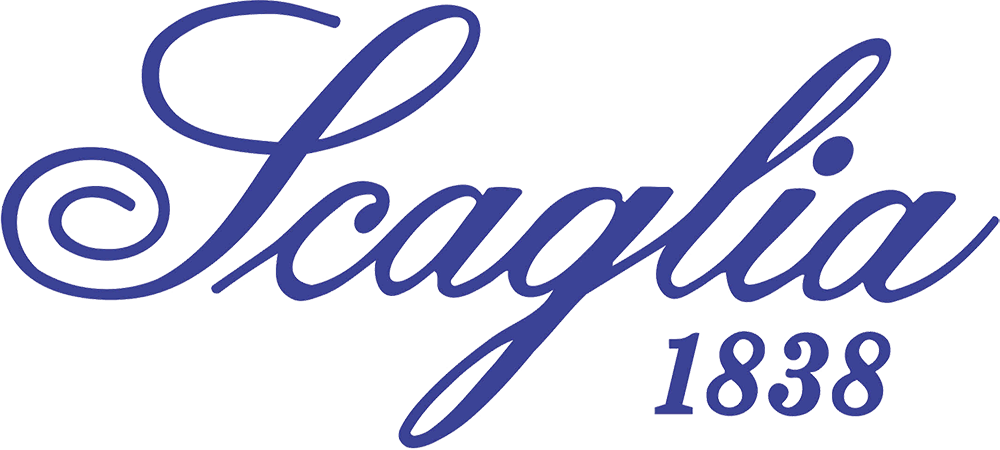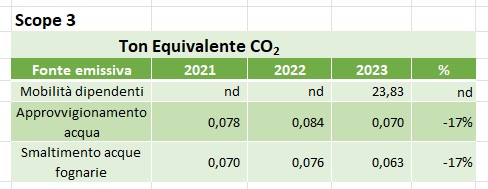Index
The Context
we are a company that finds its historical origins at least as far back as 1838.
The company has always been owned by the Scaglia family and constituted the starting nucleus of the group of companies that is recognized in the “Scaglia Group”, an important group of companies with interests and activities in multiple industrial sectors, operating in the main countries of the world, with commercial branches and production sites ready to meet the needs of the market.
Located in Brembilla, about 20 km from Bergamo and just over 50 km from Milan, its production and headquarters are concentrated here, in a production area shared with some of the group’s companies.
Scaglia Srl began its production linked to the wood supply chain, evolving its product over time and moving on to metal-mechanical techniques and technologies, replacing the raw material with light aluminum alloys and plastic materials.
This evolution has projected Scaglia Srl to the top of the market, earning it absolute leadership in the yarn support production sector of the global textile machinery industry.
Company objectives and Stakeholders
The primary objective of every company is to create PROFIT.
Profit can be seen in multiple facets:
- dividends to shareholders,
- regular remuneration of employees,
- payment of suppliers;
- compliance with the payment of taxes and duties;
- donations to non-profit associations.
These objectives can be achieved:
- promoting health and safety in the workplace;
- respecting the environment;
- encouraging the increase of the company’s technological park;
- with the increase in company know-how;
- through cultural updating of staff for specific company skills;
- encouraging the cultural updating of staff even in the face of extra-work activities;
- with the cultural updating of the non-profit associations in which employees are involved;
- supporting the skills that employees have learned in their extra-work activities;
- the search for reliable partners and suppliers;
- compliance with national and international laws and regulations.
But all this is possible ONLY when a company is able to satisfy the needs of CUSTOMERS, realizing:
- a product that meets their needs;
- a product quality that can give added value to their activities;
- a product that has a cost suited to their expectations;
- a competent customer service.
Market
The company operates mainly in the mechanical-textile sector.
Basic clientele is mainly made up of: textile machinery manufacturers; end users of textile machinery.
Ous sales network is made up of representatives present on the main reference markets.
Workforce
The average age of employees as of 12/31/2023 was 42.5 years.
All employees are covered by the Collective Agreement to which the company refers.
Below are some statistical data, updated as of 31/12/2023.
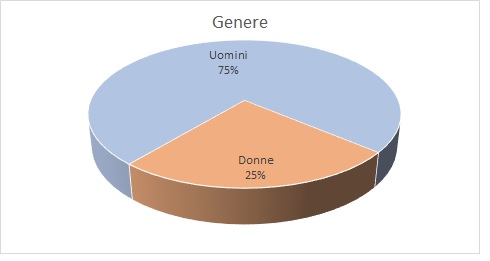
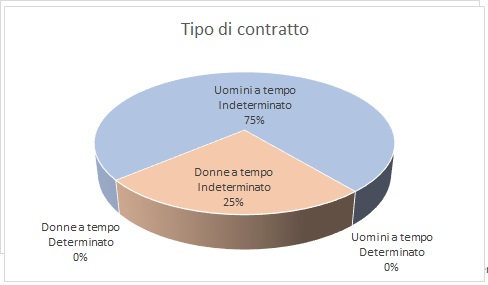
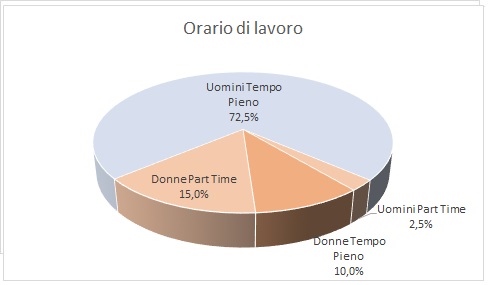
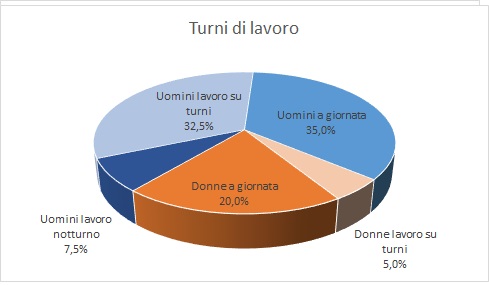
Night work is regulated with a specific operating procedure.
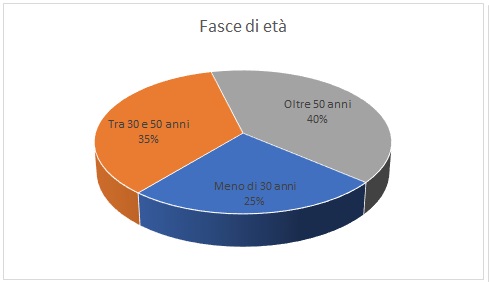
Turnover
During the year 2022 the following data occurred:
Age Man Women
< 30 years 50% 0%
>30 e < 50 years 0% 0%
> 50 years 33% 0%
Total 23% 0%
The overall turnover value for the year 2022 is 18%.
Turnover means the ratio between: sum of employees who have left the organization, who have resigned, who have reached retirement age; who have been included in the organization; the total number of employees.
Overtime
The use of overtime occurs to deal with unexpected workloads.
Part of the hours is paid, part of the hours is entered into the hour bank.
The choice is left to each individual worker.
Child Labor
Child labor is regulated by a specific operating procedure.
The procedure specifically indicates the activities PROHIBITED by law and for each department there is a summary diagram of the compatible activities.
The procedure is given in copy to the parents of minors, who sign that they have received information.
During 2023, the minors present worked for 2.3% of the total hours worked in the company.
Minors are prohibited from working overtime.
Their use is aimed at their training and education.
The Journey
The distance of employee residences from the workplace is summarized in the following numbers:
- minimum distance is 350 meters
- while the maximum distance is 35 km
- and the average distance is 8.99 km.
- 10% of employees arrive at work on foot
- 5% of employees arrive by motorcycle
- 2.5% of employees use public transport.
- Traveling less than 5 km = 37.5% of employees
- over 5 km and less than 10 km = 25% of employees
- more than 10 km and less than 15 km = 17.5% of employees
- over 15 km and less than 20 km = 15% of employees
- more than 20 km = 5% of employees.
On average, in a standard working day, employees travel 371.5 outward journeys + 371.5 return journeys = 743 km. A reduction of 8.7% compared to year 2022.
Only 2 employees organized themselves independently with car sharing.
The analysis of the residences gives an indication of how difficult it is to implement an organized car sharing system.
In addition to the numerical data, it must be taken into consideration that quite different work shifts alternate in the company: day work, full time, part-time in the morning, part-time in the afternoon, 3-shift work..
Safety in the workplace
The management of safety in the workplace is governed by Italian D.Lgs. 81/08 and its subsequent amendments and additions.
A fundamental part of safety management is collected in the Risk Assessment Document, periodically updated in its reference operational annexes.
During the year 2023 the severity index (days of absence / hours worked) is equal to 0.67; the frequency rate (injuries / hours worked) is equal to 15.8.
The magnitude of injuries ((severity index * frequency index) is equal to 10.54.
As part of prevention, training courses are regularly organized and the deadlines for implementing specific assessments for work activities are verified.
Water Consumption
The company does not carry out direct water withdrawals, such as:
surface sampling, groundwater sampling, sea water sampling. The company does not even use water taken from third parties.
Water supply takes place entirely through the municipal aqueduct network.
The uses in 2023 were:
- Fire prevention network
- Civil use (bathrooms, showers, drinking water dispensers, coffee machines)
- Civil use for the company canteen
- Industrial use
Fire prevention network: 2 m3 of water were consumed for network tests.
Civil use: annual consumption is estimated at 396 m3 of water.
Industrial use: annual consumption is estimated at 17 m3 of water.
Water discharge occurs through:
– the sewage system (civil water)
– the disposal of industrial liquids through authorized companies,
– evaporation.
Municipal waste
The company provides the following waste through the organization of the Municipality of Val Brembilla:
undifferentiated waste, separate collection of plastic, separate collection of organic waste, separate collection of paper, separate collection of glass and cans.
Only waste collected in the offices, break areas and company canteen is transferred to the municipal system.
The workers have the possibility of correctly separating the waste through specific containers placed in the main areas. The items compatible with the container are shown on the containers.
As regards waste from the canteen, separation is entrusted to the manager, who disposes of the collected material in special bins.
The origin of this waste can be traced back to:
coffee dispensers, snack dispensers, food and drinks brought into the company by employees, paper and cardboard used in office activities, plastic packaging used for office activities, company canteen.
The wooden or compostable material paddle has been introduced in coffee dispensers and the cups are made of cardboard.
The paper collected in the offices originates:
from the archive, from the production of paper documents used for administrative and organizational activities, books and magazines.
From the canteen premises the production of waste concerns:
organic, paper and cardboard, glass, cans, plastic and undifferentiated waste.
There is no count of the quantity of material delivered through this disposal/recovery channel.
Industrial waste
The company delivers its waste through specialized and authorized companies for transport, treatment, recovery and disposal.
The nature of industrial waste can be divided into 3 macro categories:
– production waste (scraps, metal shavings);
– originating from auxiliary activities (toner, mixed packaging, paper and cardboard);
– accessory to direct production activities.
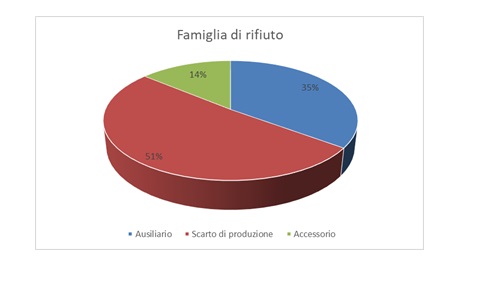
In this category as a whole, 99.68% is destined for recovery plants (R13 classification).
Compared to the previous year of operation, a 22% reduction in industrial waste was recorded
Polymer packaging
Our company participates in the PRS – Pallet Return System program.
For more than 20 years the project has been part of a Circular Economy system and manages the supply of reusable pallets for the European petrochemical industry.
Through a supply to producers of materials and a large recovery network that acts on end users, the organization allows efficient reuse that reduces waste and carbon emissions, takes care of reliability and safety, providing for any repairs.
If reuse is no longer possible, the pallet is sent for disposal as a form of biomass.
Also during the year 2023 Scaglia Srl earned the Certificate of Appreciation from the PRS program for having started reusing more than 65% of the pallets received.
Supplies in silos
Some supplies of plastic material, when operational and economic needs existed, were supplied via tank trucks and stored in specific silos.
If the supply had taken place in the traditional way, the following would have been used for packaging:
410 kg of waste in the form of polyethylene;
1,890 kg of wood;
40 kg of film.
Overall it is therefore 2,340 kg that were not produced.
It should also be remembered that in any case:
– bags would be sent to a recovery plant;
– pallets would be restarted under the PRS program;
– film would be sent to a recovery plant.
Electric Power
The driving force of Scaglia Srl is represented solely and exclusively by electricity coming from the national distribution network.
During 2023, 36% less energy was consumed compared to 2022.
Wanting to report energy intensity, it was considered to analyze the relationship between energy consumed and hours worked.
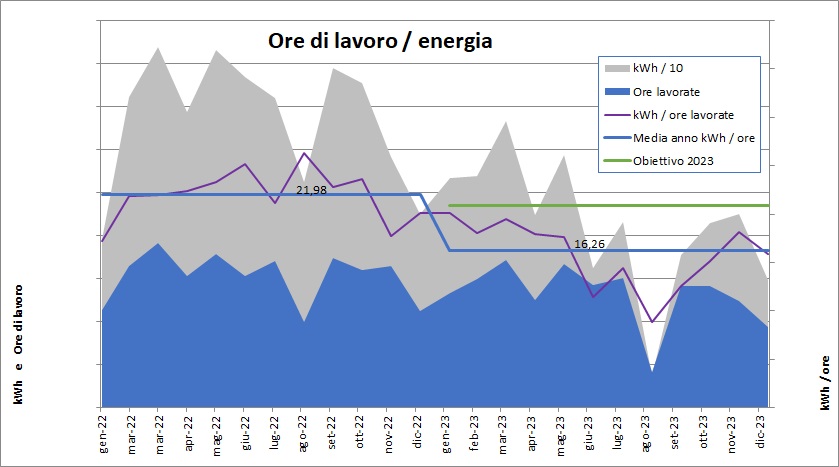 The intensity value for 2023 is 16.25 kWh / hours worked, which represents a decrease of 26% compared to the energy intensity of the previous year.
The intensity value for 2023 is 16.25 kWh / hours worked, which represents a decrease of 26% compared to the energy intensity of the previous year.
TARGET was to contain the reduction to -5% but it was NOT achieved.
The 2021 benchmark of 18.10 kWh/hour worked is more significant and in fact comes close to the value achieved in 2023.
Approximately 4% of the energy consumed comes from the photovoltaic system installed during 2023.
Natural Gas
Natural gas is used only and exclusively for heating offices and production departments.
The supply of methane gas takes place only and exclusively from the national distribution network.
During 2023, 34.123 nm3 of natural gas were consumed. Against the consumption of 27,800 nm3 in 2022. An overall reduction of 8.5%.
Wanting to report the energy intensity, it was considered to analyze the relationship between energy consumed and the “DD Degree Days (20/12)”, i.e. it is the sum extended to all days of a conventional annual heating period, of only the daily positive differences between the ambient temperature, conventionally set at 20°C, and the average daily external temperature.
The calculation of the DD(20/12) is obtained by processing the data of the ARPA Lombardia weather station, present in a sports facility in the municipal area of Val Brembilla.
The DD(20/12) of 2023 amount to 2,515°. Compared to the 2022 value of 2,534°.
It follows that the intensity value for 2023 is equal to 13.56 nm3 / DD, which represents a decrease of 7.8% compared to the energy intensity of the previous year.
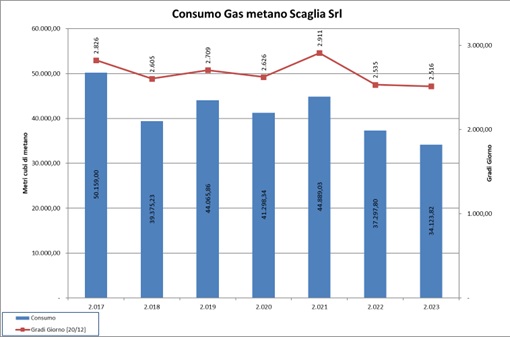
Considerations: the provisions of the law on energy saving and the careful management of switch-on times have meant that both the absolute values of consumption (m3) and the relative value (compared to the degree days) have been reduced.
The Fuel
During the year 2023, company vehicles consumed a total of 3,158 liters of diesel, corresponding to an emission of 8.34 tons of CO2.
Compared to the previous year, there is a reduction of 25.7%.
The Raw Materials: the plastic material
Not taking pigments into account, the quantity transformed was 15% LOWER than the previous year.
NON RECYCLABLE material transformed in 2023 is represented by 0.07% of the total.
The Raw Materials: the Tube
The light aluminum alloy tube is used in the production of the Scalital department.
It is mainly purchased from Italian transformers, who, if necessary, issue certificates on the percentage of recycled material.
The standard average declared by the main supplier stands at a percentage of use of recycled material equal to 80%.
Since no specific requests have been received from customers at the moment, this data is considered sufficient.
Tubes consumption for 2023 saw a 10% decrease compared to year 2022. But a +12% if compared to 2021
At the end of the spool’s life, the light aluminum alloy tube can be 100% RECYCLED.
The Raw Materials: the Bars
The light aluminum alloy bars are used in the Scalital department, mainly in the production of spool flanges.
They are mainly purchased from Italian transformers or from normal national trade.
Bar consumption for 2023 saw a 38% decrease compared to the previous year.
At the end of the spool’s life, the light aluminum alloy flanges can be 100% RECYCLED.
Raw Materials: NON RECYCLABLE MATERIAL
A non-recyclable raw material is used in the production of the Scalital department. This material is purchased from Italian producers and subjected to European Community regulations.
The material is 100% NON RECYCLABLE.
This material, among other things, has great potential as a fuel, having a high calorific value. Even in the past, it was not possible to find anyone on the market who was interested in its use in this form of energy.
Its consumption for 2023 saw a decrease of 25% compared to the previous year.
CO2 Emissions
In consequence of what mentioned in the previous paragraphs, we can determine the CO2 emissions:
Scope 1: direct emissions
These are the climate-altering emissions generated directly by the company: they come from plants, assets and vehicles managed directly.
This category includes natural gas used for heating and fuels for the company fleet.

Scope 2: indirect emissions
These are the indirect emissions resulting from the generation of electricity purchased by the company which, with these purchases, indirectly contributes to the emissions generated by energy suppliers.

Scope 3: indirect emissions occurring in the value chain
They are generated by business operations from sources that are not directly owned or controlled by an organization, such as the supply chain, transportation, employee mobility, use or disposal of products.
Also called value chain emissions, they are the most difficult to measure and reduce.
As better specified in the previous chapters, during 2023, employee travel data, the means of transport used, the frequency of trips from their home to the workplace and vice versa were collected.
In addition to this data, emissions for the supply and disposal of drinking water supplied by the municipal aqueduct through the sewage system were also considered.
2024 Targets
Accidents at workplace: 0 accidents
Electricity: energy/hours worked ratio: – 2%
Methane: nm3/degree day ratio: -2%
Punctual accounting of the water consumed in the Production departments.
Introduction of the Supplier Code of Conduct.
Featured mage from Immagine di Freepik
sustainability 2023 sustainability 2023 sustainability 2023 sustainability 2023 sustainability 2023
sustainability 2023 sustainability 2023 sustainability 2023 sustainability 2023 sustainability 2023
